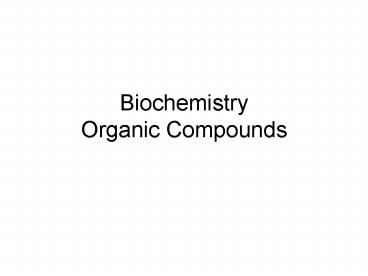Biochemistry Organic Compounds - PowerPoint PPT Presentation
Title:
Biochemistry Organic Compounds
Description:
Biochemistry Organic Compounds What are organic compounds? Organic Compounds - have carbon bonded to other atoms and determine structure/function of living things ... – PowerPoint PPT presentation
Number of Views:127
Avg rating:3.0/5.0
Title: Biochemistry Organic Compounds
1
BiochemistryOrganic Compounds
2
What are organic compounds?
- Organic Compounds - have carbon bonded to other
atoms and determine structure/function of living
things - Inorganic Compounds - do not contain carbon and
hydrogen together (salt) - ALL LIVING THINGS CONTAIN CARBON.
3
Organic Compounds
- Carbon, Hydrogen, Oxygen, Nitrogen, Phosphorus
and Sulfur are found in all living things - CHONPS
4
Monomers and Polymers
- Monomers building blocks (units)
- Polymers a larger molecule made of monomers
- Analogy Example-
- If a brick house is the
- polymer, what is the
- monomer?
- _________________
- Monomers link together to form polymers.
- MONO means one. POLY means many.
5
Four types of Organic Compounds
- Organic Compounds fall into four categories
- Carbohydrates
- Lipids
- Protein
- Nucleic Acids
- Organic Compounds are also known as
MACROMOLECULES (macro means BIG)
6
1. Carbohydrates
- monosaccharides monomers of simple ring sugars,
glucose and fructose - disaccharides - two monosaccharides combined,
sucrose and lactose - polysaccharides - polymers (long chains of
repeating units) of monosaccharides, starch
(plant energy storage) and glycogen (animal
energy storage)
7
Carbohydrates
- Polysaccharides as Structural Molecules
- Cellulose - glucose bonded to form "fibers",
composes cell walls in plants (cotton is almost
pure cellulose) not easily digested - Chitin - polymer of glucose, makes up
exoskeletons of insects and arthropods such as
scorpions and crabs.
8
Carbohydrates
- Find the monosaccharide, disaccharide, and
polysaccharide
9
Carbohydrates
- CARBO-(carbon)-HYDR-(hydrogen)-ATE (oxygen)
- Carbohydrates are composed of carbon, hydrogen
and oxygen in a 121 ratio. - Example- glucose
- C6H12O6
10
2. Lipids
- Hydrophobic (insoluble in water) (Oil and water
dont mix) - Used for insulation and long term energy storage
(Fat) - Waxes mainly used for covering and protection
- Phospholipids - Important structural component of
the cell membrane - Steroids - cholesterol sex hormones (estrogen
testosterone)
11
Lipids
- Fats Oils are made of subunits glycerol and
fatty acids
12
Lipids
- Lipids REPEL water.
- Plants have a waxy layer made
- of lipids on their leaves
- (helps keep water in).
- Many aquatic birds have a waxy lipid layer on
their feathers (repel water to keep feathers
dry). - Fat is a lipid- we use it to store excess energy.
13
Lipids
- Phospholipids found in cell membrane.
- They make sure the cell cant
disintegrate in water (maintain
the cells integrity).
14
Lipids
- Fats can be saturated or unsaturated.
- Saturated fats contain no double bonds,
unsaturated have double bonds that kink the
molecule - Saturated fats solidify at room temperature
unsaturated fats are liquid at room temperature
15
Lipids- Saturated vs. Unsaturated Fats
Saturated fats have single bonds and are solid at
room temperature (the S rule!)
Unsaturated fats have double bonds, which create
kinks (makes them loose and bendy). They are
liquid at room temperature.
16
Saturated or Unsaturated?
________________________ ___________________
______ (contains single bonds) (contains
double bonds)
17
3. Proteins
- Polymers made of amino acids, which are joined by
peptide bonds - proteins are also called
polypeptides - Amino acids form a wide variety of structures,
mainly building blocks for living tissue - Support Enzymes Transport Defense
Hormones Motion - Amino Acids are the building blocks (monomers) of
proteins!
18
Proteins
- There are thousands of proteins- but only 20
different amino acids. - Think of it as if you had to make one thousand
different sweaters with only 20 different colors
of yarn. How would you do that?
19
Proteins
The function of the protein has everything to do
with the SHAPE of the protein. There are many
different ways that proteins can fold in order to
make different shapes- protein folding is very
complex!
20
4. Nucleic Acids
- Polymers made of individual nucleotides
- Contain genetic Information
- DNA (deoxyribonucleic acid) RNA (ribonucleic
acid) - (Nucleotides are the monomers).
21
Nucleic Acids
- Each nucleotide consists of
- 1. A sugar (deoxyribose or ribose)2. A
phosphate3. A nitrogen base -
adenine - thymine -
guanine - cytosine -
uracil (in RNA)
22
Nucleic Acids
- ATP (adenosine triphosphate) - high energy
molecule that contains three phosphate bonds that
are easily broken to release energy (this energy
drives the reactions in our bodies) - ATP is an RNA nucleotide with two extra
phosphates- does not contain genetic information.
ATP STORES ENERGY.
23
(No Transcript)
24
- Polymers are large molecules made up of smaller
units called _____________. - Carbon, hydrogen, oxygen, nitrogen, __________
and _____________ are the six elements found in
all living things. - Material that is organic contains ___________.
- The four organic compounds are carbohydrates,
____________, proteins, and ________________. - Carbohydrates are divided into three classes
monosaccharides, ______________, and
_______-_______________. - If a molecule known to be a carbohydrate has 6
carbon atoms and 12 hydrogen atoms, how many
oxygen atoms must it have? ________
25
- Fats, steroids, and waxes are which type of
organic compound? _____________ - _____________ fats are fats that contain double
bonds between carbon and hydrogen atoms (CH) - _____________ fats contain single bonds (C-H) and
are solid at room temperature. - Another word for protein is ________________.
- Proteins are polymers made up of monomers called
__________ ________. - Nucleic acids are made up of 3 main parts sugar,
phosphate, and ________________. - ATP is a type of nucleic acid that stores
_________.
26
(No Transcript)































